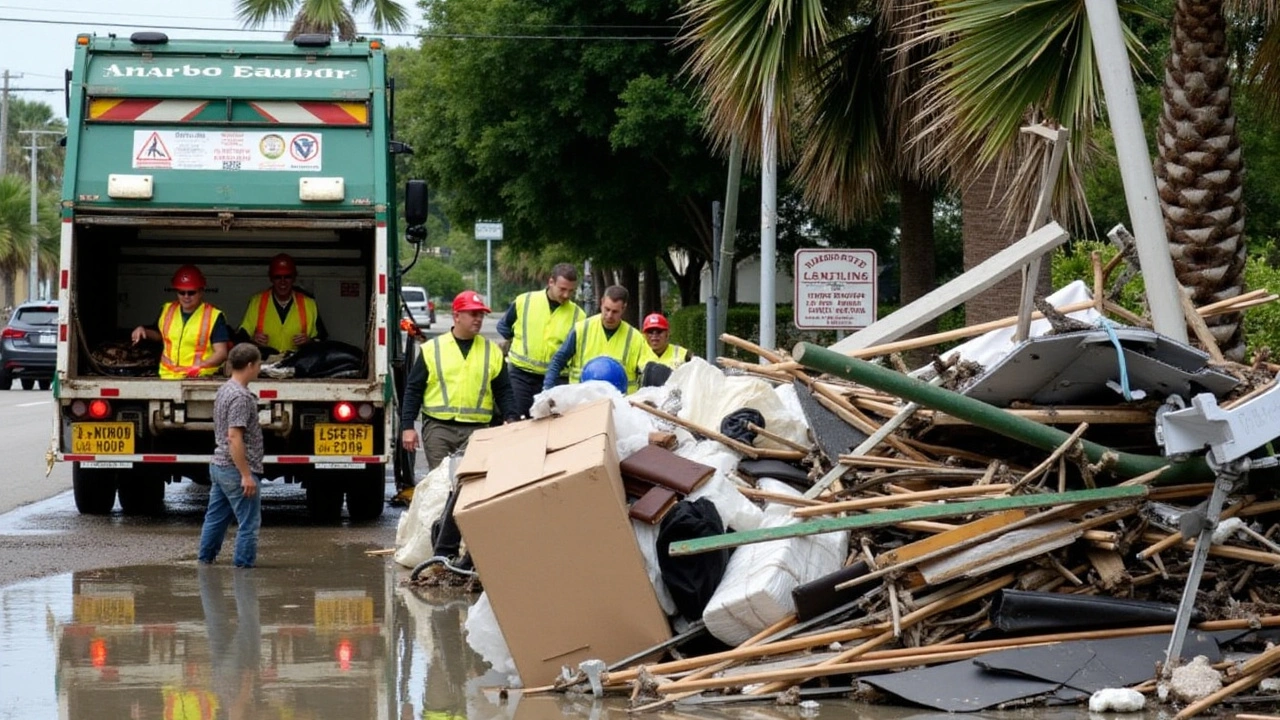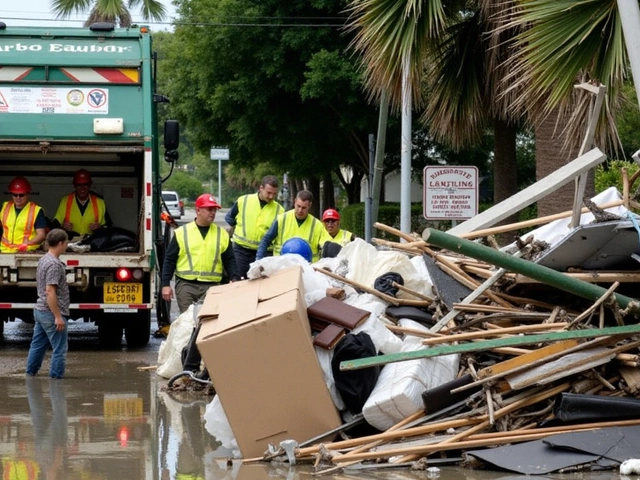Hurricane Milton's Progression and Intensification
As Hurricane Milton churns with increasing intensity in the Gulf of Mexico, the looming storm presents a significant threat to Florida's Gulf Coast. Over the past few days, meteorologists have closely monitored its rapid development, as it accelerates towards becoming a Category 5 hurricane, bringing with it the potential for catastrophic impact. Current weather models predict Milton's path will lead it directly towards Florida, where it is expected to make landfall between 6 p.m. ET and midnight on Wednesday. Such explosive development in the Gulf is not unheard of, though it demands comprehensive preparations from authorities and residents alike.
The current state of the storm is an impressive and daunting force of nature. At present, Hurricane Milton has sustained winds well over 155 mph, solidifying its classification as a Category 4 storm. However, forecasts anticipate conditions that could soon push it to Category 5 status. The cause is attributable to exceptionally warm waters in the Gulf of Mexico that fuel its intensity, coupled with favorable atmospheric conditions that allow such storms to grow more powerful by the hour. This raises significant concerns for impacted areas on Florida's coastline, underscoring the urgency of the evacuation advisories currently in place.
Florida's Preparedness and Response to Evacuation Orders
In response to the looming danger presented by Hurricane Milton, authorities across Florida have enacted sweeping evacuation campaigns to ensure the safety of residents in at-risk regions. The state's emergency management teams have been mobilized, preparing shelters and organizing evacuation routes to facilitate the safe departure of millions residing in Milton's potential path. With approximately 15 million people throughout Florida under flood alerts, the risk posed by the impending storm surge and rising waters remains a primary concern that drives the state's preparation strategy.
Alongside the threat of extreme winds and flooding, the risk of tropical tornadoes further complicates the region's readiness plans. Alerts have been issued for nearly 11 million residents, set to experience dangerous tornado activity on Tuesday and Wednesday, stemming from Milton's sprawling storm bands. Such multi-faceted threats require extensive coordination between state agencies and local communities, as officials stress the importance of adhering to evacuation advisories to minimize risks to human life. However, challenges remain, as Florida continues its recovery from the devastation left by the relatively recent Hurricane Helene, further stretching the capacity of emergency response units.
The Anticipated Impact of Landfall
The critical question now is just how much Hurricane Milton may weaken before hitting Florida's shores. Current predictions suggest that while the storm maintains formidable strength in its approach, it will begin to lose some intensity as it nears the coastline, possibly dropping to a Category 3 status by the time of landfall. This could mitigate the most catastrophic impacts of the hurricane but still poses a significant risk to the infrastructure and communities along its path.
Even at a slightly reduced strength, Milton is expected to deliver severe weather conditions across a wide area, including violent winds, torrential rainfall, and a potent storm surge capable of breaching coastal defenses. The economic and social impacts of such an event can be profound, with potential disruption to transportation, communication networks, and basic utilities, which can take weeks or even months to fully restore. Such scale potential disasters underscore the importance of rapid and thorough response and recovery efforts to secure the well-being of affected populations.
In Conclusion: Staying Informed and Prepared
As Florida braces itself for what could be a defining weather event of the year, clear communication and community resilience play pivotal roles in reducing the storm's potential toll. It is crucial for residents in the shadow of Hurricane Milton to stay informed through reliable sources, taking all necessary precautions as advised by local authorities. Such storms remind us of the dynamic and at times unpredictable nature of our weather systems, and the importance of preparedness, both individually and collectively, to weather the storms that come our way.
Ultimately, as Hurricane Milton makes its approach, the prevailing sentiment among forecasters and emergency managers is one of cautious optimism. While the threat is very real, with the right actions and community cooperation, Florida can navigate this latest challenge as it seeks to shield its inhabitants from the full force of nature's fury.



Comments
Alright folks, think of this as a chance to rally. Even if Milton looks scary, we can prep our homes, stock supplies, and stay calm. Keep an eye on official alerts.
Yo, that’s a real *storm* thingy-like nature’s gonna throw a massive party, but not the fun kind. gotta double‑check those evacuation routes, brotha.
Honestly, the news hype is overblown; Milton will probably fizzle out.
The mesoscale dynamics suggest a rapid drop in vorticity as the system interacts with continental friction. Such interaction typically reduces the maximum sustained winds by a few knots. However, the pressure gradient remains steep, sustaining gust potentials. Expect localized shear zones to spawn tornadoes. Planning must incorporate these micro‑scale threats.
Wow, this is wild 😱. If Milton hits hard, imagine the power outages 😩. Hope everyone’s got their kits ready 🙏.
Stay positive keep those supplies stocked 😊 you’ll get through this
When I think about the Gulf Coast, I’m reminded of the countless stories my grandparents told about old hurricanes that reshaped entire towns.
Milton, with its blistering 155‑plus mph winds, is no ordinary visitor; it’s like a giant, angry ocean breathing fire onto the land.
The warm waters that are feeding it right now are almost like a giant pan on a stove, turning up the heat on an already volatile system.
What’s more, the atmospheric steering currents are aligning in a way that leaves little room for the storm to lose steam before arrival.
Even though models suggest a possible downgrade to a Category 3 at landfall, the sheer momentum it carries will still be enough to rip roofs off houses that aren’t properly anchored.
And let’s not forget the storm surge, which can push several feet of water inland, breaching sea walls that were designed for weaker tempests.
In my experience, the true damage often comes from water inundating basements and low‑lying neighborhoods, turning streets into rivers.
That water then mixes with debris, creating mudslides that can block roads for weeks, making rescue operations a nightmare.
Beyond the physical destruction, there’s the emotional toll on families who have to evacuate, leave behind cherished belongings, and live in shelters.
The psychological stress can linger long after the winds die down, affecting mental health and community cohesion.
Economically, the hit to tourism, agriculture, and local businesses can set the region back for years, especially when power grids take months to fully recover.
This is why the coordinated effort of FEMA, state agencies, and local volunteers is absolutely critical.
Every checkpoint, every sandbag, every battery pack counts toward saving lives and reducing long‑term hardship.
If you’re in the evacuation zone, pack non‑perishable food, water, medicines, and important documents in a waterproof bag.
Stay connected via a battery‑powered radio, because cell towers are often the first to go dark.
In the end, our resilience isn’t just about weather‑proofing houses; it’s about looking out for each other and rebuilding together, stronger than before.
While the poetic lament is appreciated, let’s be realistic-Florida’s infrastructure has been hardened over the past decade, and an organized response will mitigate most of the speculative chaos you paint.
Indeed, the engineering upgrades to levees and building codes have reduced vulnerability, yet the stochastic nature of rapid intensification still poses non‑trivial risk that must be factored into emergency drills.
Listen up folks we need to rally our neighborhoods stock up on water food meds and check on elders together we can get through this
Don’t trust the official bulletins they’re hiding the real scale of Milton-they want us to stay scared so they can push their agenda.
To quantify the risk, we should examine the Integrated Kinetic Energy (IKE) of Milton, overlay it with the Coastal Vulnerability Index, and communicate the probabilistic hazard curves to the public in accessible terms.